ChatGPT is an extension of OpenAI’s GPT-3 language model. It was built from the ground up with chatbots in mind and is trained using a massive database of actual talks between real people.
One of ChatGPT’s most distinguishing features is its ability to read and write in a naturalistic manner. It can analyse the flow of a discussion and come up with relevant responses on the go. This makes it perfect for use in chatbots, which attempt to simulate human dialogue.
In addition to its ability to produce natural-sounding text, ChatGPT also provides a number of other useful functions. Popular “chatbot” commands like “help” and “menu” are understood and responded to by this example. Train it on specific topics or domains, and it will be able to produce more accurate and relevant responses to user enquiries.
ChatGPT’s capability to acquire new knowledge and modify its behaviour over time is one of its most appealing features. The more discussions it hears, the more it will understand English and be able to come up with the right responses. As a result, it is a powerful resource for chatbot applications that depend on precise and consistent responses.
ChatGPT’s scalability is an additional major advantage. It’s scalable to meet the demands of high-traffic chatbot applications like customer service and e-commerce. Because of this, it is the best option for businesses who want to streamline their operations and automate their interactions with customers.
As a result of its flexibility and capacity to mimic human speech, ChatGPT is a great option for numerous chatbot uses. If you’re wondering if people are making money with chatgpt, it’s worth knowing it is ideally suited for businesses who want to automate their customer interactions and boost their operations’ efficiency, because of its scalability and capacity to learn and improve over time.
What is ChatGPT? How does it function?
A language model called ChatGPT, a variation of the GPT (Generative Pre-training Transformer), has been trained to produce text that resembles human speech in response to a suggestion. It is a sort of artificial intelligence (AI) that produces coherent and pertinent responses to a variety of cues using cutting-edge machine learning algorithms.
ChatGPT uses a technique called “language modelling” to produce its responses, which involves predicting the following word in a string of words based on the context of the words that came before it. For instance, ChatGPT might produce the response “Elon Musk is a business magnate, industrial designer, and engineer” in response to the query “Who is ElonMusk.”
ChatGPT analyses input and use its internal algorithms as well as its understanding of language structure to produce output text that is cohesive and pertinent to the prompt. It achieves this by converting the input into a format that may be used to produce output text, a process known as “transduction.”
Overall, ChatGPT is a potent tool that can produce text that resembles that of a human being depending on a given prompt, enabling it to take part in discussions and offer pertinent and cogent responses to a variety of cues.
Benefits of Using ChatGPT
- Capability to generate human-like content
ChatGPT is able to interpret and generate text that is eerily similar to that produced by humans since it is trained on a vast dataset of human-human chats. As a result, it’s great for usage in chatbot applications, where it can respond to user questions with human-like conversational fluency.
- Chatbot command recognition
Common chatbot instructions like “help” and “menu” are understood by ChatGPT and acted upon accordingly. Because of this, it can assist users in finding the information they seek and using the chatbot effectively.
- Domain-specific training
In order to better answer user questions, ChatGPT can be trained on a variety of different topics and domains. Because of this, it is highly suitable for use in chatbot applications that necessitate specialised knowledge, such as those found in customer service and technical support.
- Capacity for long-term learning and change
ChatGPT’s language comprehension and answer generation capabilities grow with its exposure to more and more chats. As a result, it is a powerful resource for chatbot applications that depend on precise and consistent responses.
- Scalability
Because of its scalability and adaptability, ChatGPT can be implemented in a wide range of chatbot use cases. Because of this, it is the best option for businesses who want to streamline their operations and automate their interactions with customers.
Drawbacks of ChatGPT
- Inadequate grasp of nuance and context
ChatGPT’s capacity to comprehend and produce natural-sounding text is promising, but it may still have some growing pains when it comes to picking up on the subtleties of human communication. This can cause people to react in ways that are awkward or misconstrued.
- Having to rely on a lot of training data
ChatGPT is able to interpret and generate text that is eerily similar to that produced by humans since it is trained on a vast dataset of human-human chats. This also means that a huge amount of training data is necessary for it to function properly.
- Constrained ability to change and adapt
It’s possible that ChatGPT, despite its ability to learn and improve over time, won’t be able to handle every unexpected circumstance. Because of this, it may be less versatile and adaptable than competing chatbot technologies that are quicker learners and more versatile.
- Possibility of partiality
Bias in ChatGPT could arise from the data it was trained on, as it would in any machine learning system. In order to reduce the likelihood of bias in ChatGPT’s responses, it is crucial that a broad and representative set of training data be used to construct the chatbot.
- Maintenance and updating are required
ChatGPT will need regular servicing and updates to keep functioning optimally. So that it may perform better and adapt to new circumstances, it may need to be trained on fresh data and have its parameters tweaked.
Is using ChatGPT free?
OpenAI created GPT-3, which includes ChatGPT, as a proprietary technology that is not currently available for free. You must create an OpenAI API account and pay for the use of the API on a per-request basis in order to utilise ChatGPT or any of the other GPT-3 models. The cost of using the API varies according to the particular GPT-3 model and the quantity of requests made.
It is important to note that the GPT-3 models, such as ChatGPT, are extremely complex language models that have been trained on a substantial dataset of text that has been produced by humans. They can produce high-quality, human-like language as a result, but this comes at a cost in terms of the time and resources needed to create and maintain them.
Also Read:
- How to Fix “Last Line No Longer Available” on iPhone
- A Complete Guide on How to Copy and Paste on iPhone
- How to Delete Facebook Account Using Desktop and Android Or iOS
- Easiest Way to Enter Text with Your Voice on a Chromebook
Pricing for ChatGPT

ChatGPT and the other GPT-3 models are priced differently depending on the number of API calls made and the chosen GPT-3 model. OpenAI does not publish its prices publicly and makes them available only to customers who have created an API account.
It’s important to remember that processing large numbers of requests using the GPT-3 models (which includes ChatGPT) might be rather pricey. This is because of the time, effort, and knowledge needed to create and keep up such complex models.
Sign up for an API account and get a price quote from OpenAI if you want to use ChatGPT or any of the other GPT-3 models. This will help you calculate the total cost of using the API in your chatbot app and decide if it is worth it to you.
Who came up with ChatGpt?
When it comes to language models, ChatGPT is a variant of OpenAI’s GPT (Generative Pre-training Transformer). GPT is a machine learning model that has been taught to produce natural-sounding responses to certain questions. The GPT model was created by scientists at OpenAI, a nonprofit organisation that studies and advocates for AI that is kinder to humans. It wasn’t until 2018 that the first version of the GPT model was made public, and since then, other modifications have been created, including ChatGPT. These models are capable of generating coherent and meaningful responses to a wide variety of stimuli since they have been trained on enormous databases of human-generated text.
Is it possible to use ChatGPT as a search engine?
ChatGPT is not a search engine; it’s a chat room. In this case, the prompt is used to train a language model based on the GPT (Generative Pre-training Transformer) family of models to provide natural-sounding output. ChatGPT has the ability to generate responses to a wide number of questions and deliver knowledge on a variety of topics, but it is limited to the information it has been trained on and cannot search the internet or access external information.
Conversely, a search engine is a programme that helps people find data online according to certain criteria. In order to help consumers obtain relevant results for their queries, search engines crawl and index websites and other online resources using complex algorithms. Search engines like Google, Bing, and Yahoo are just a few examples.
Comparison of the Gpt-3 and ChatGPT Models

OpenAI’s GPT-3 is a big language model with the ability to generate natural-sounding text. It can interpret and generate content based on the context and style of the input it gets because it was trained on a vast dataset of human-generated text.
The ChatGPT model is a specialisation of the GPT-3 model made for usage in conversational interfaces. Because of its extensive training on a database of human talks, it can comprehend and produce writing that is strikingly close to that of a human. ChatGPT is well-suited for usage in chatbot applications due to its capacity to generate human-like prose as well as its ability to understand and respond to basic chatbot commands and to be taught on specific themes or domains.
In general, ChatGPT is a more customised version of the GPT-3 model that is suited for chatbot applications. It is able to interpret and generate human-like text in a conversational setting, making it a great solution for chatbot creators aiming to create interesting and natural-sounding chatbot encounters.
Support for ChatGPT
ChatGPT could be used to provide the following services, among others:
- ChatGPT could be used to create chatbots for customer service that are intelligent enough to comprehend questions and requests from users and answer in a conversational, human-like form.
- Chatbots for e-commerce: ChatGPT might be used to create bots that help shoppers find what they’re looking for and place orders.
- ChatGPT could be used to create chatbots that understand and respond to technical assistance queries in a natural, human-like manner.
- ChatGPT could be used to create general purpose chatbots for a wide range of purposes, such as presenting information, answering inquiries, or offering assistance with chores.
Over all, ChatGPT is a strong and flexible platform for chatbot developers, allowing them to create chatbots for a multitude of uses.
Coding Capable in ChatGPT?

ChatGPT is a language model that is based off of the GPT (Generative Pre-trained Transformer) language model, which is a machine learning model that is taught to generate text that is convincingly human. It is not designed to develop software or do any activities beyond creating text.
However, it is possible to employ a language model like GPT to aid in software development chores, such as creating code snippets or suggesting adjustments to existing code. One way to accomplish this is to train a model with information about the task at hand and the background knowledge it needs, and then use the resulting text as a jumping-off point for your own creations.
It is important to note that while a language model like GPT can generate writing that is comparable to human-written text, it is not capable of understanding the meaning or purpose of the material it generates, and as such, it cannot execute tasks or make decisions on its own. It is ultimately up to the developer to use their own skills and experience to build software and make judgements about the design and implementation of their projects.
Can ChatGPT revolutionise marketing?
Future effects of ChatGPT and other technologies on marketing are murky at best. Companies’ interactions with customers and potential clients may be forever altered by ChatGPT and other cutting-edge machine learning models.
Creating chatbots or virtual assistants that can interact with clients and offer tailored recommendations or help is one potential application of ChatGPT in the realm of marketing. In order to communicate with customers on their website or social media platforms, a business may utilise ChatGPT to create a chatbot that can do things like respond to questions and give out information about the company’s products and services. This has the potential to improve firms’ consumer engagement, which in turn could increase customer loyalty and revenue.
The development of customer-specific content is another another area where ChatGPT could be used in marketing. Using a customer’s history of interactions and preferences, a business could tailor email advertisements and social media posts using ChatGPT. Because of this, marketing campaigns may become more targeted and successful.
When combined with other forms of cutting-edge machine learning technology, ChatGPT has the potential to revolutionise the way businesses approach marketing by facilitating more targeted, efficient interactions with consumers.
Will ChatGPT make programmers obsolete?
We shouldn’t expect ChatGPT or any other AI technology to do away with programmers anytime soon. While advances in artificial intelligence and machine learning promise to streamline many aspects of the software development process, they are still a long way from eliminating the need for human coders altogether.
The capacity to think abstractly and creatively, as well as a solid grasp of problem-solving, are also essential in the field of programming. It seems unlikely that AI systems will be able to entirely replace the function of human programmers any time soon because of how difficult it is for them to mimic these talents.
Even said, AI and ML technologies may one day assist programmers in accomplishing more or doing so more efficiently. AI technologies could, for instance, be used to automate coding tasks like testing and debugging, or to recommend code snippets or answers to programming issues. But human computer programmers would still be required for the initial creation and ongoing upkeep of these technologies.
In conclusion, AI and machine learning technologies will likely continue to play an increasingly essential role in software development in the future, but they are unlikely to totally eliminate the need for human programmers.
What Are ChatGPT’s Limits?
While ChatGPT or any other language model may seem ideal, it does have some restrictions.
- The text that language models generate cannot be understood by the model itself. In order to generate new text, they must first apply the patterns and associations they have learnt from their training data.
- Language models are unable to carry out tasks or make judgements on their own. They are limited to producing written content and cannot carry out duties or understand the significance of what they write.
- While language models can produce text that is linguistically and stylistically comparable to human-written text, they cannot comprehend or create text in the same way that people can. In turn, the content they produce may include typos or be too complex for human readers to comprehend.
- To what extent a language model’s output text is accurate and relevant depends heavily on the quality and relevance of the data used to train it. The quality and suitability of the text generated by the model may be compromised by the poor quality or inadequacy of the training data.
- Language models may pick up on the inherent biases in their training data. When applying language models to activities like content generation or data analysis, it is necessary to be aware of and take into account these biases.
A Possible Alternative to Google Search?

While services like Google Search are great for quickly finding the information you need, language models like ChatGPT take a more nuanced approach to understanding language. While language models can be taught to produce text that is eerily similar to human writing, they are unable to do tasks such as searching the web or accessing other databases.
If you’re looking for something in particular on the internet, Google Search is your best chance, while language models like ChatGPT are more effective when asked to do things like generate text or aid with language-related chores. Both methods have their uses, and it’s up to the user to determine which method is best in any specific scenario.
When compared to Quora, do you believe ChatGPT will win out?
Quora is an online community in which people may ask and answer questions about any topic they like. The site’s widespread success can be attributed to its high-quality material and its experts’ willingness to share their ideas on a wide range of topics.
It’s unlikely that ChatGPT and other advanced machine learning technologies will entirely replace platforms like Quora very soon, despite their potential to automate some chores and generate high-quality material. Quora and comparable platforms offer a valuable user experience that is difficult, if not impossible, for an AI to recreate.
However, ChatGPT and other forms of advanced machine learning technology may one day be utilised to enrich Quora’s (or another platform’s) existing material. For instance, you may use ChatGPT to come up with new material, or share your own unique take on a subject. However, the significance of any given technological advancement will be determined by the manner in which it is utilised and adopted by various groups and individuals.
Google Coding Interview Questions: Can ChatGPT Help?
It is feasible that ChatGPT or other advanced machine learning technologies might theoretically be used to solve coding challenges in an interview situation, but it is unclear that they will be able to totally replace the requirement for human programmers in the near future.
The capacity to think abstractly and creatively, as well as a solid grasp of problem-solving, are also essential in the field of programming. It seems unlikely that AI systems will be able to entirely replace the function of human programmers any time soon because of how difficult it is for them to mimic these talents.
However, ChatGPT and similar advanced machine learning technologies have the ability to supplement programmers’ efforts and make some activities easier or more efficient. For example, ChatGPT might potentially be used to suggest code snippets or solutions to programming challenges or to automate the testing and debugging of code. However, it is vital to emphasise that these tools would still need to be planned, developed, and maintained by human programmers.
Overall, while ChatGPT and other advanced machine learning technologies may have the ability to aid with coding chores in some instances, it is unclear that they will be able to totally replace the need for human programmers in the near future.
Does ChatGPT retain previous discussion history?
ChatGPT is a language model that has been trained to create natural-sounding responses to questions using a variant of the GPT (Generative Pre-training Transformer) model. ChatGPT has the ability to recall and make references to previous remarks and events when utilised in a discussion. As a result, ChatGPT is able to provide users with meaningful and appropriate responses, giving the impression that it is a human being having the conversation. ChatGPT, however, is not a human being and so cannot remember or recall previous discussions in the same manner that a real person would. Simply defined, it’s a tool that can generate text based on the information it’s fed using sophisticated machine learning methods.
What makes ChatGPT a game-changer?
One reason why ChatGPT could be considered a disruptive technology is that it has the potential to revolutionize the way that companies and organizations communicate with their customers and stakeholders. For example, ChatGPT could be used to develop chatbots or virtual assistants that can interact with customers and provide personalized recommendations or assistance. This could help companies to better engage with their customers and build stronger relationships, leading to increased customer loyalty and sales.
Another reason why ChatGPT could be considered a disruptive technology is that it has the potential to automate certain tasks that are currently performed by humans. For example, ChatGPT could potentially be used to generate high-quality content for websites or social media platforms, freeing up time for human writers and content creators to focus on other tasks.
Overall, ChatGPT and other advanced machine-learning technologies have the potential to disrupt a wide range of industries and fields by automating certain tasks and improving the efficiency of communication and information processing. However, it is important to note that the impact of any specific technology will depend on how it is used and adopted by different organizations and individuals.
FAQ
What is ChatGPT? How does it function?
ChatGPT is a language model that is based off of the GPT (Generative Pre-trained Transformer) language model, which is a machine learning model that is taught to generate text that is convincingly human. The system generates language that is very close to human-written material by digesting an input and applying the patterns and relationships it has learned from a big dataset.
What is the purpose of ChatGPT?
ChatGPT’s many uses include text generation, language assistance, and even as a foundation for additional software engineering work.
When generating text, how accurate is ChatGPT?
ChatGPT’s ability to generate natural-sounding language depends on the quality and relevancy of the data it was trained on, as well as the nature of the task at hand. ChatGPT can produce text that looks and sounds like human writing, but it may be grammatically incorrect or otherwise challenging to human readers.
Does ChatGPT comprehend the meaning of the text it creates?
Unfortunately, ChatGPT cannot comprehend the meaning of the text it creates. Only the patterns and correlations it has learnt from its training data can be used to generate new text.
Do ChatGPT’s actions and decisions stand on their own?
Without human intervention, ChatGPT cannot carry out tasks or make choices. It is only able to generate text and does not have the ability to analyse the meaning or implications of the text it generates.
What makes ChatGPT unique compared to other language models and resources like Google Search?
ChatGPT is a language model that can generate natural-sounding text, and Google Search is a search engine that can provide appropriate results depending on a user’s input.
Any restrictions on utilising ChatGPT?
It is possible for ChatGPT to reflect the biases existing in the data it was trained on, it lacks the ability to understand and fulfil tasks, and it cannot generate fully original content or ideas.
What do I do to start using ChatGPT?
Inputting a prompt or set of instructions into ChatGPT will cause the model to output text in response to the given input. The model can be tailored to your needs by allowing you to train it with your own data and specifying parameters.
How flexible is ChatGPT? Can I use my own data to train it?
ChatGPT is adaptable in that it can be trained on user-supplied data or run through a set of custom parameters. Modifying the model in this way can help you produce better-suited content for your project or yield better results overall.
Will you find any prejudice in ChatGPT?
It’s possible that ChatGPT’s biases stem from its training data. When applying the model to activities like content development or data analysis, it is crucial to be cognizant of and account for these biases.
More Read:






